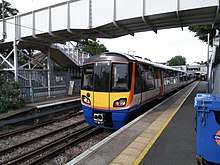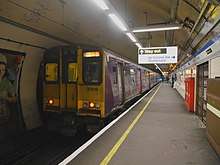Highbury & Islington station
Highbury & Islington is a London Underground and National Rail interchange station in the London Borough of Islington, north London. It is served by the London Underground's Victoria line and the Great Northern's Northern City Line, as well as the London Overground's East and North London Lines.[5]
| Highbury & Islington | |
|---|---|
 | |
 Highbury & Islington Location of Highbury & Islington in Greater London | |
| Location | Highbury & Islington |
| Local authority | London Borough of Islington |
| Managed by | London Underground[1] |
| Station code | HHY |
| DfT category | C2 (Great Northern platforms) F1 (London Overground) |
| Number of platforms | 8 |
| Accessible | Yes (Overground platforms only) |
| Fare zone | 2 |
| London Underground annual entry and exit | |
| 2014 | |
| 2015 | |
| 2016 | |
| 2017 | |
| 2018 | |
| National Rail annual entry and exit | |
| 2014–15 | |
| – interchange | |
| 2015–16 | |
| – interchange | |
| 2016–17 | |
| – interchange | |
| 2017–18 | |
| – interchange | |
| 2018–19 | |
| – interchange | |
| Key dates | |
| 26 September 1850 | Opened (NLR) |
| 28 June 1904 | Opened (GN&CR) |
| 1 September 1968 | Opened (Victoria line) |
| 1975 | Closed (Northern line (Highbury branch)) |
| 1976 | Opened (Northern City Line) |
| February 2010 | Overground platforms rebuilt |
| 1 June 2010 | North London Line platforms re-opened |
| March 2011 | East London Line platforms opened |
| Other information | |
| External links | |
| WGS84 | 51.5458°N 0.1050°W |
On the Victoria line the station is between Finsbury Park and King's Cross St Pancras. On the Northern City Line it is between Essex Road and Drayton Park, 2 miles 21 chains (3.6 km) down the line from Moorgate. On the North London Line of the Overground it is between Caledonian Road & Barnsbury and Canonbury. It is the terminus of the East London Line, with Canonbury the preceding station.
It is the 13th busiest station in the UK with over 30 million people a year using it in 2018/19 according to Office of Rail and Road statistics.
The station is in Travelcard Zone 2.[6]
History
The current station derives from two earlier stations. The first, which was on the same site, was a Victorian-gothic building, designed by Edwin Henry Horne, with a drive-in forecourt, opened on 26 September 1850 by the North London Railway (NLR) and called 'Islington'. Following reconstruction, it was renamed 'Highbury & Islington' on 1 July 1872.[7][8]
The second station, on the opposite side of Holloway Road, was opened on 28 June 1904 by the Great Northern & City Railway (GN&CR) on its underground line between Finsbury Park and Moorgate. It was renamed to Highbury & Islington on 20 July 1922.[9] This line and stations were operated by the Metropolitan Railway and its successors from 1913 until 1975 when the line, by then called the Northern City Line, was transferred to British Rail. The route is now operated by Great Northern.
The NLR station was damaged by a V-1 flying bomb on 27 June 1944; however, its main building remained in use until it was demolished in the 1960s during the building of the Victoria line. The original westbound platform buildings remain, as does a small part of the original entrance to the left of the present station entrance.
The present single-storey structure was built in the 1960s for the opening of the Victoria line on 1 September 1968 and is the entrance for all lines. When the escalators to the deep-level platforms were opened, the GN&CR station building was closed. Its disused entrance remains and was refurbished externally in 2006 – it houses signalling equipment for the Victoria line.[10]
The Victoria line was built to give as many interchanges as possible with Underground and British Rail lines, with, wherever possible, cross-platform connection between different lines heading in the same direction. To this end, at Highbury & Islington the northbound Northern City Line platform was reallocated to the southbound Victoria line to give a direct link between the two southbound platforms; a new northbound platform was constructed for each line; the northbound running NCL tunnel was diverted to its new platform; and the southbound Victoria line tunnel was joined to the old northbound NCL tunnel.
Former train operating company Anglia Railways ran services known as London Crosslink from Norwich to Basingstoke via Stratford, which called at Highbury & Islington. This service operated from 2000 until 2002.
To allow new four-car trains to run on the London Overground network, the North London Line between Gospel Oak and Stratford was closed between February and May 2010 while a new signalling system was installed and 30 platforms were extended. During this closure, the Highbury & Islington station ticket hall was extended and step-free access installed on all of the London Overground platforms. The North London Line reopened on 1 June 2010; however, the East London Line platforms did not open until March 2011, whilst the Western Curve was reinstated, linking the station to Dalston Junction and the rest of the East London Line.[11]
Platforms
Highbury & Islington has a total of eight platforms, divided between those that are on the surface and those that are deep level:
- Platform 1 – London Overground (East London Line) services to Crystal Palace
- Platform 2 – London Overground (East London Line) services to West Croydon (Clapham Junction on Sundays)
- Platform 3 – Northbound Victoria line
- Platform 4 – Northbound Northern City Line
- Platform 5 – Southbound Victoria line
- Platform 6 – Southbound Northern City Line
- Platform 7 – London Overground Westbound North London Line
- Platform 8 – London Overground Eastbound North London Line
Surface platforms
Platforms for North London Line (NLL) and East London Line (ELL) services are operated by London Overground. On 1 June 2010, following the temporary closure of the route from February 2010 to May 2010, NLL services were rerouted to the newly built platforms 7 and 8 for the AC lines, which replaced the old "special use" platform. Platforms 1 and 2, which previously served the NLL route on third rail lines, were closed from February 2010 for reconstruction and reopened in 2011 for the ELL services. The change of platforms allows ELL services to operate without having to cross over NLL tracks. An island platform provides platforms 2 and 7, platforms 1 and 8 are side platforms. When the ELL extension to Clapham Junction was first instituted in December 2012, trains ran through to Clapham Junction from this station throughout the week. Following a timetable change in December 2014, they only do so on Sundays, with West Croydon the second destination served alongside Crystal Palace on weekdays & Saturdays.
Deep-level platforms
Platforms 3 to 6 are deep-level platforms. Platforms 3 and 5 are used for services on the Victoria line; 4 and 6 are used for Northern City Line services.
Services
London Overground

All times below are correct as of May 2016.
East London Line
Mondays to Saturdays there is a service every 6–9 minutes throughout the day, while on Sundays before 13:00 there is a service every 15 minutes, changing after that to every 7–8 minutes until the end of service.[12]
North London Line
Mondays to Fridays there is a service approximately every 7–8 minutes throughout the morning and evening peaks, changing to roughly every 10 minutes off-peak. On Saturdays the service is approximately every 10 minutes. Sunday services are similar in frequency to the services on Saturdays.[13]
Finsbury Park to Highbury & Islington to Dalston | ||||||||||||||||||||||||||||||||||||||||||||||||||||||||||||||||||||||||||||||||||||||||||||||||||||||||||||||||||||||||||||||||||||||||||||||||||||||||||
|---|---|---|---|---|---|---|---|---|---|---|---|---|---|---|---|---|---|---|---|---|---|---|---|---|---|---|---|---|---|---|---|---|---|---|---|---|---|---|---|---|---|---|---|---|---|---|---|---|---|---|---|---|---|---|---|---|---|---|---|---|---|---|---|---|---|---|---|---|---|---|---|---|---|---|---|---|---|---|---|---|---|---|---|---|---|---|---|---|---|---|---|---|---|---|---|---|---|---|---|---|---|---|---|---|---|---|---|---|---|---|---|---|---|---|---|---|---|---|---|---|---|---|---|---|---|---|---|---|---|---|---|---|---|---|---|---|---|---|---|---|---|---|---|---|---|---|---|---|---|---|---|---|---|---|
| ||||||||||||||||||||||||||||||||||||||||||||||||||||||||||||||||||||||||||||||||||||||||||||||||||||||||||||||||||||||||||||||||||||||||||||||||||||||||||
Great Northern

Mondays to Fridays there is a service approximately every 4–15 minutes until 10:00, when the frequency is every 10 minutes until 16:00, when the frequency again changes to between every 4–15 minutes until the end of service.[14] Prior to December 2015, weekend and evening services were diverted to Kings Cross from Finsbury Park.[15] Northbound trains run alternately to Welwyn Garden City and to Hertford North, with hourly extensions to Letchworth on weekdays and Stevenage at weekends.
London Underground
Connections
London Buses routes 4, 19, 30, 43, 271 and 393 and night routes N19 and N41 serve the station.
References
- "Safety boost as London Underground to take control of 11 Silverlink stations". Transport for London. 5 December 2006. Archived from the original on 13 December 2014. Retrieved 19 February 2015.
- "Multi-year station entry-and-exit figures (2007-2017)" (XLSX). London Underground station passenger usage data. Transport for London. January 2018. Retrieved 22 July 2018.
- "Station Usage Data" (CSV). Usage Statistics for London Stations, 2018. Transport for London. 21 August 2019. Retrieved 27 April 2020.
- "Station usage estimates". Rail statistics. Office of Rail Regulation. Please note: Some methodology may vary year on year.
- "Home - Transport for London". www.tfl.gov.uk. Retrieved 2 December 2015.
- TFL.gov.uk
- Butt 1995, pp. 120,128.
- Chronology of London Railway by H.V.Borley
- Butt 1995, p. 120.
- "Metronet News Issue 8 (page 7)" (PDF). Archived from the original (PDF) on 31 October 2006. Retrieved 11 April 2007.
- "In Pictures: The East London Line Extension To Highbury & Islington". Londonist. 28 February 2011. Retrieved 2 December 2015.
- Table 178 National Rail timetable, May 2016
- Table 59 National Rail timetable, May 2016
- Table 24 National Rail timetable, May 2016
- "Seven-day-a-week service to the City better for late-returning commuters and weekend shoppers" (Press release). Govia Thameslink Railway. 5 November 2015. Retrieved 15 November 2015.
- Journeyplanner.tfl.gov.uk
- Journeyplanner.tfl.gov.uk
Butt, R. V. J. (1995). The Directory of Railway Stations: details every public and private passenger station, halt, platform and stopping place, past and present (1st ed.). Sparkford: Patrick Stephens Ltd. ISBN 978-1-85260-508-7. OCLC 60251199.
External links
| Wikimedia Commons has media related to Highbury & Islington station. |
- Original NLR station
- London Transport Museum Photographic Archive
- GN&CR station building, shortly after the Metropolitan Railway's absorption into the London Underground, 1933
- Side entrance to GN&CR building on to Highbury Crescent, 1934
- Ticket hall of GN&CR station, 1935
- Combined ticket hall, 1970
- Northern City Line southbound platform, 1975
- Combined ticket hall, 2005
- Entrance to station (note remnant of original NLR building on left), 2005
- Geoffrey Tribe's Railway Photo Halt
| Preceding station | Following station | |||
|---|---|---|---|---|
towards Brixton | Victoria line | towards Walthamstow Central |
||
| Preceding station | Following station | |||
towards Richmond or Clapham Junction | North London Line | towards Stratford |
||
| Terminus | East London Line | towards Crystal Palace or West Croydon |
||
| Great Northern | ||||
| Former Service | ||||
| Camden Road or West Hampstead |
Anglia Railways London Crosslink |
Stratford | ||
| Preceding station | Following station | |||
towards Finsbury Park | Metropolitan line Northern City Branch (1913-39) | towards Moorgate |
||
| Northern line Northern City branch (1939-75) | ||||
| Abandoned plans | ||||
| Northern line | towards Moorgate |
|||